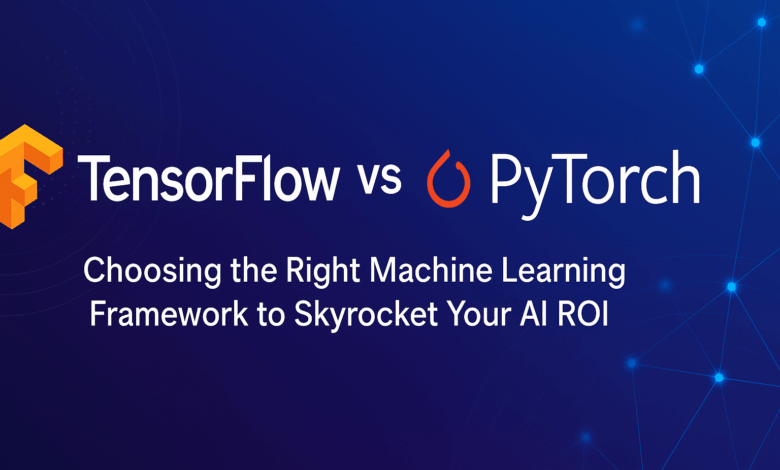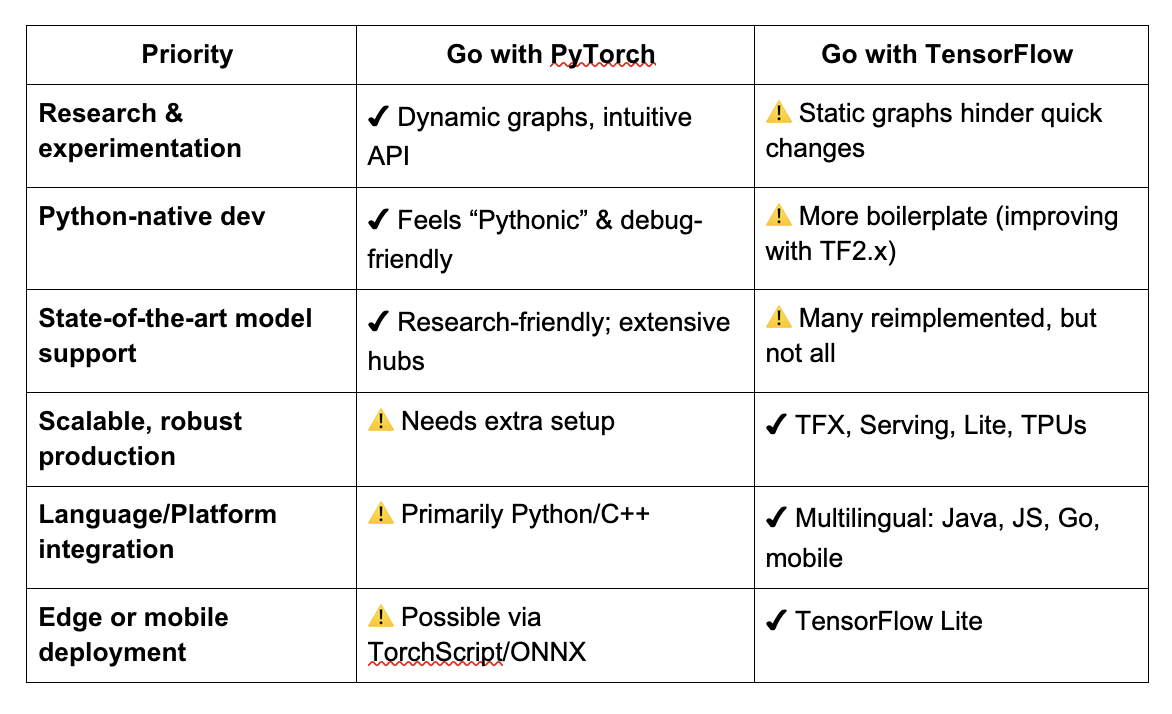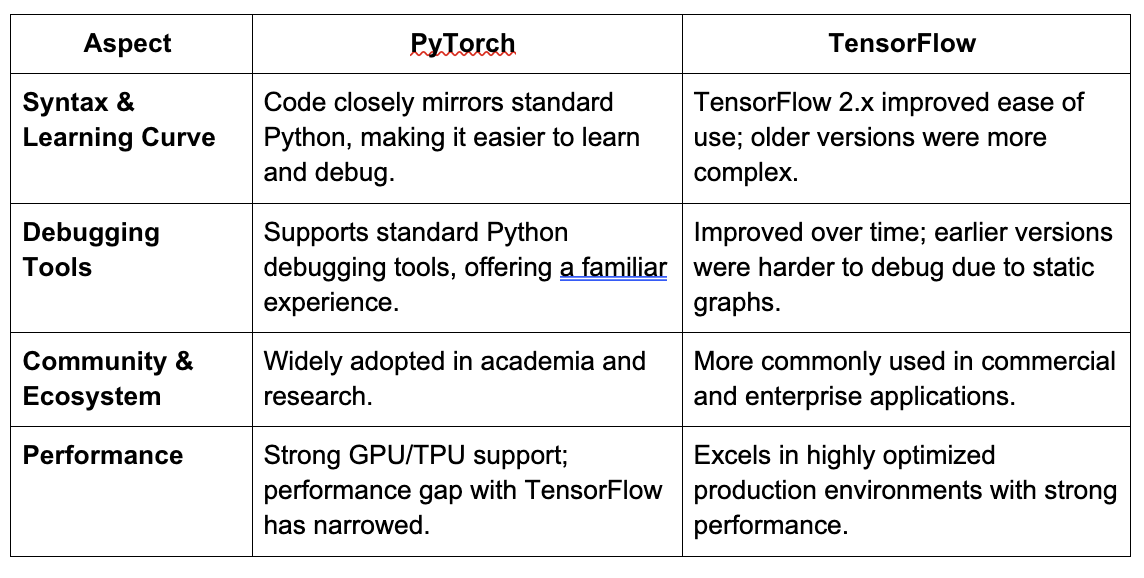
In 2025, which is the era of AI, choosing the appropriate machine learning framework is very important. At first, you will think that TensorFlow and PyTorch are almost identical, as they both are free and open-source ML frameworks. But both have different benefits to offer, and they also impact your return on investment.
Let’s explore in detail which platform is providing more benefits than the other.
Framework History & Features
TensorFlow
In 2015, for a production-ready and scalable machine learning platform, TensorFlow was developed and launched by Google Brain. It was built to support production-ready and scalable machine learning workflows. Within a short time, it becomes a preferred platform for enterprise-level AI applications.
Major Features
- Provides integration production tools for deployment across platforms like TensorFlow Lite & TensorFlow serving.
- TensorBoard for debugging and monitoring visualization abilities.
- For managing end-to-end machine learning pipelines, TensorFlow Extender is available.
- Get flexibility across different development and deployment workflows with environment capabilities and wide languages.
- For smoother integration and optimized performance, Tensor Processing Units and Google Cloud Platform are available.
PyTorch
Originally, it was developed by Meta AI, PyTorch emerged in 2016–2017 as a dynamic, Python‑centric deep learning library. PyTorch has a feature named “dynamic computational graphs,” which helps in adaptability & flexibility during the development process. For complex and innovative, this is well-suited for experimenting.
Major Features
- Smooth integration with Python & compatibility with standard debugging tools.
- Makes development flexible and intuitive with dynamic computation graphs.
- Provides high-level abstractions by PyTorch Lightning for more structured and cleaner code.
- Have generative AI abilities, which are powered by deep integration with Hugging Face Transformers.
- For broader deployment options model export supports ONNX and Torchscript.
PyTorch vs TensorFlow: what to use when
PyTorch and TensorFlow have many common use cases that can be used for building any deep learning model virtually. Also, each of them has exceptional strengths that make it perfect for some strategies.
When to Choose PyTorch
Following are the priorities in which PyTorch is the best choice
- For beginners in machine learning, PyTorch is the most accessible and comes with user user-friendly interface.
- PyTorch is especially best for iterative experimentation and prototyping due to its flexible, dynamic computational graphs.
- The integration of PyTorch with Python gives it the feel and look of native Python frameworks, which offers a workflow that feels familiar and natural to Python developers.
When to Choose TensorFlow
TensorFlow is a more suitable choice when the developers need to prioritize these
- For enhanced model performance in production environments, TensorFlow’s static computational graphs allow advanced optimizations during the development process.
- For development, training & deployment, and streamlined workflow, TensorFlow is a supportive tool; it also reduces the need for external frameworks.
- As we know, TensorFlow supports more languages than Python. The projects that require integration with non-Python environments, the major advantage is their compatibility with languages like C++ and Java.
Key Differences
Which One is Easier to Learn?
PyTorch
- It is considered easier to learn, especially for those who are familiar with Python.
- It feels like writing standard Python code, which is more suitable for beginners
TensorFlow
- It was initially harder to learn due to a very complex user interface.
- It has improved significantly over time, adopting a more PyTorch-like approach.
- Now it has become more beginner-friendly than earlier iterations.
Which One has the Fastest Speed?
Both PyTorch and TensorFlow offer high performance, and they are fast enough for most projects.
Tensorflow
- A little edge in deployment systems, like smartphone apps or web-based AI systems.
- It is used for Optimization for production environments.
PyTorch
- It is often more faster & more efficient during the initial stages of experimentation and development.
- It is best for quick prototyping and testing.
Which One Should You Choose?
A simple way to decide according to the required goals
Choose PyTorch if
- You’re new to Artificial Intelligence and want a framework that looks the same as Python programming.
- You’re focused on experimenting or researching with new machine learning strategies.
- You want flexibility and have more customizable approach while building models.
Choose TensorFlow if
- You’re building AI for daily use applications such as web apps or mobile apps.
- You want access to a huge range of built-in tools and multiple deployment options
- You’re working in a company or production environment where scalability matters the most.
Best Practices to Skyrocket AI ROI
Align tech choice with goals
MVP/prototype → Keras/TensorFlow
Research/customization → PyTorch
Focus on model access
PyTorch integrates more faster with research models like SOTA.
Think end-to-end
Production pipelines → TensorFlow’s full-stack MLOps
Bridge frameworks
On a successful proof-of-concept in TensorFlow, port to PyTorch for refinement.
Invest in team skills
Hire or give training for dual-framework expertise, which will maximize your ROL in the long term.
Bottom line
Selecting between TensorFlow vs PyTorch is not just about which framework is better; it’s about choosing the one that aligns with your project goals. As we see, they have have set of benefits which will help you in your long-term goals.
Choose the one by understanding the strengths and weaknesses according to your use case and invest in an appropriate framework. So you can maximize the return on your investments in 2025.
FAQs
Is PyTorch better than TensorFlow for beginners?
Yes. PyTorch is generally easier to learn due to its Pythonic syntax and dynamic computation graphs, which make it more intuitive for those new to machine learning.
Which framework is better for production: TensorFlow or PyTorch?
TensorFlow has an edge in production environments with its mature deployment tools like TensorFlow Serving and TensorFlow Lite, making it ideal for scalable, end-to-end AI pipelines.
Can I use both TensorFlow and PyTorch in one project?
Yes. Many teams prototype with PyTorch and then port to TensorFlow for deployment, or vice versa. Bridging both can combine flexibility with scalability.
Does TensorFlow support more programming languages than PyTorch?
Yes. TensorFlow supports multiple languages like Python, C++, Java, JavaScript, and Go. PyTorch is primarily focused on Python with some C++ support.
Is PyTorch good for mobile or edge deployment?
It’s possible via TorchScript or ONNX, but TensorFlow Lite provides a more streamlined solution for mobile and edge AI deployment.







